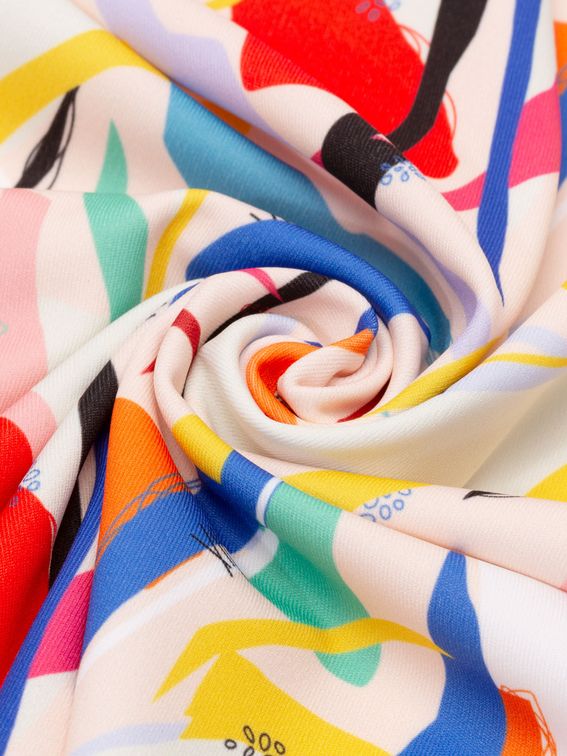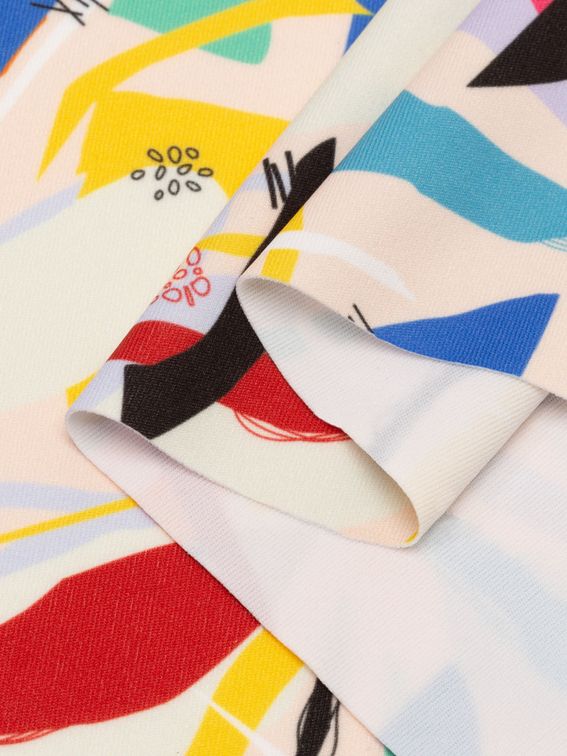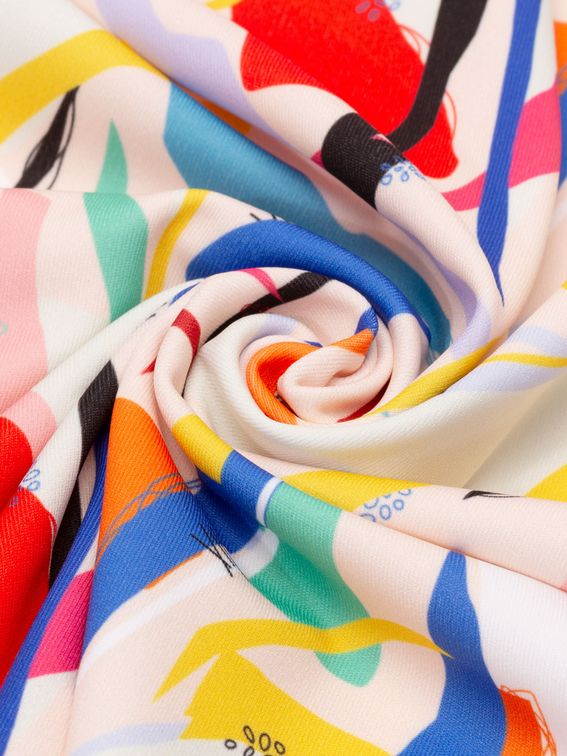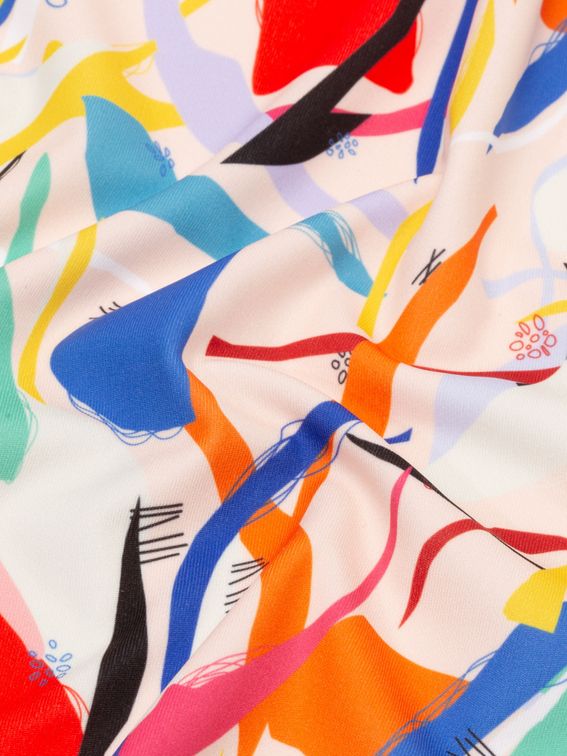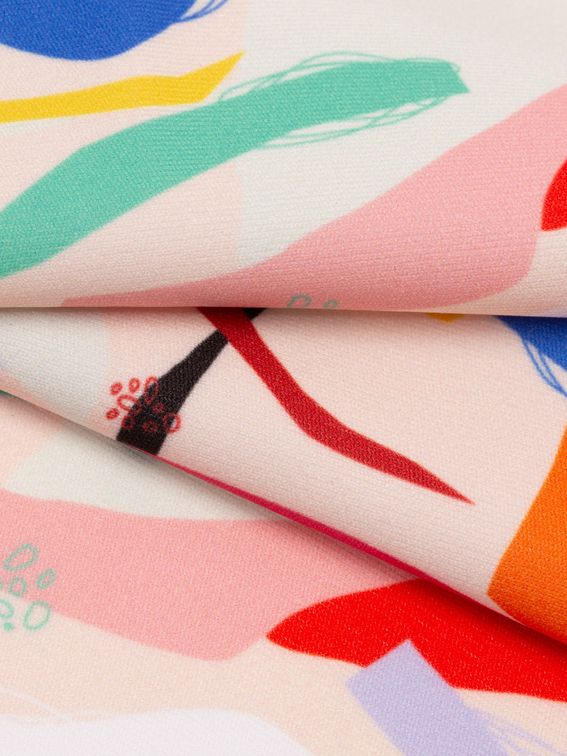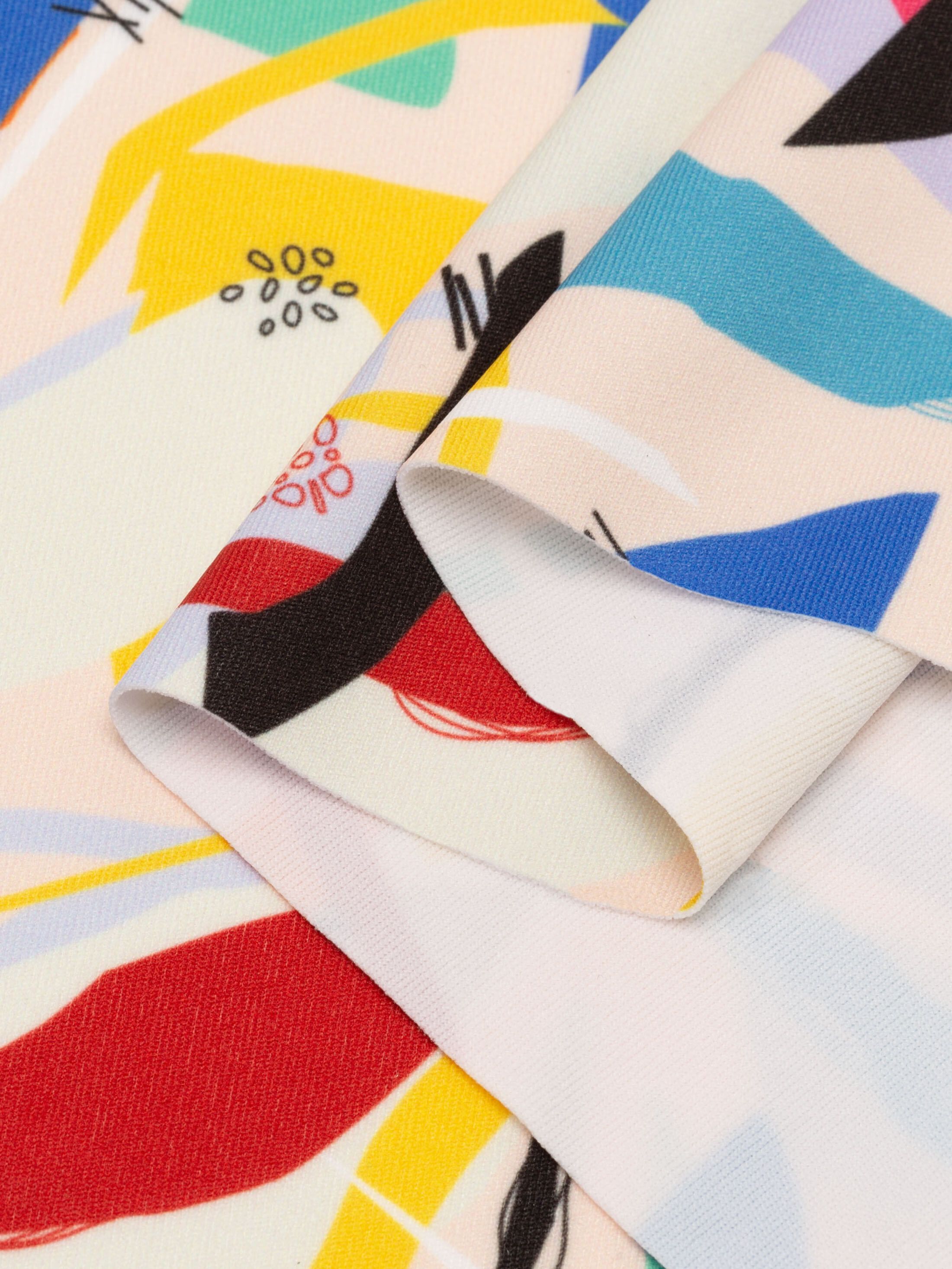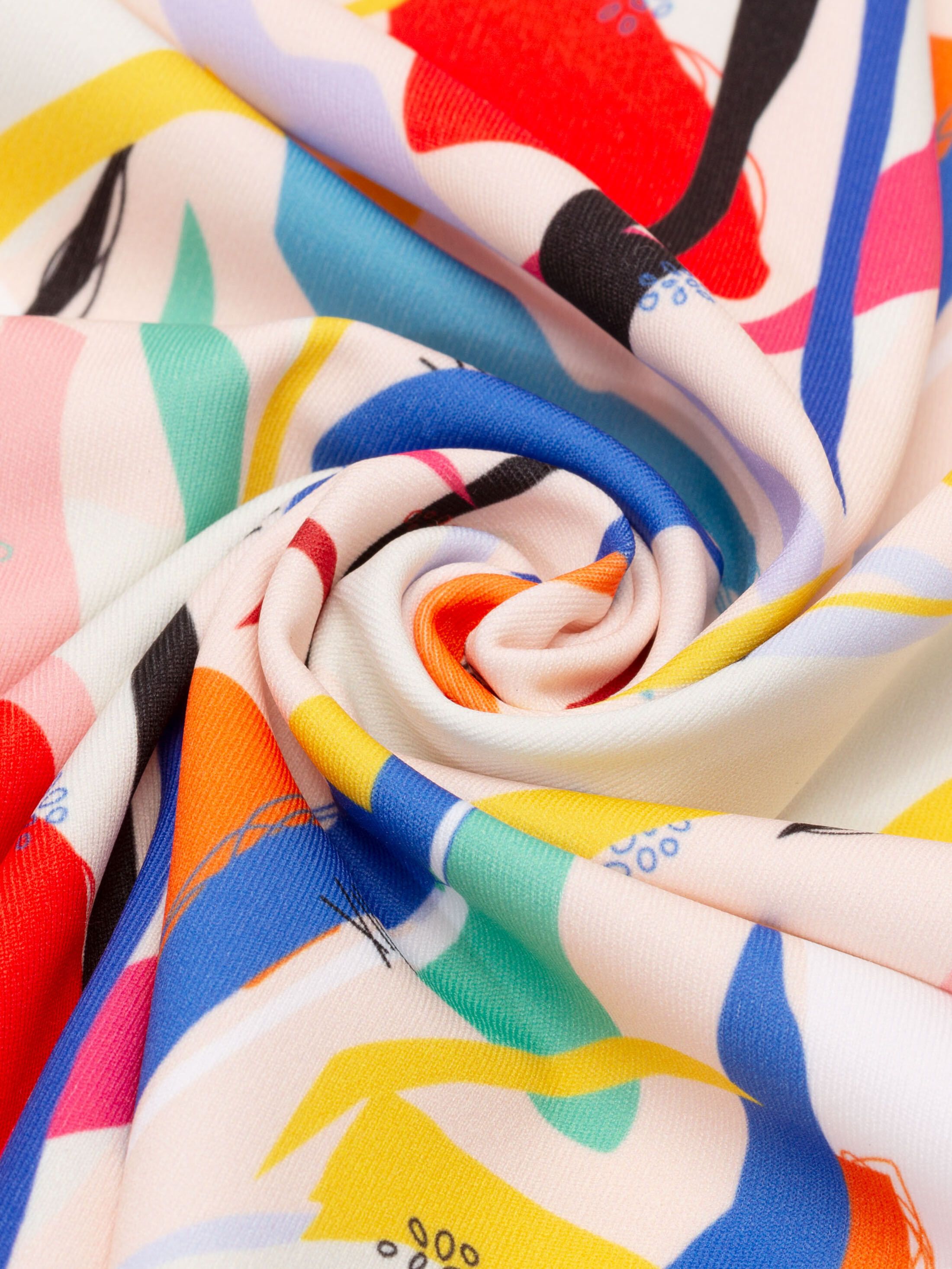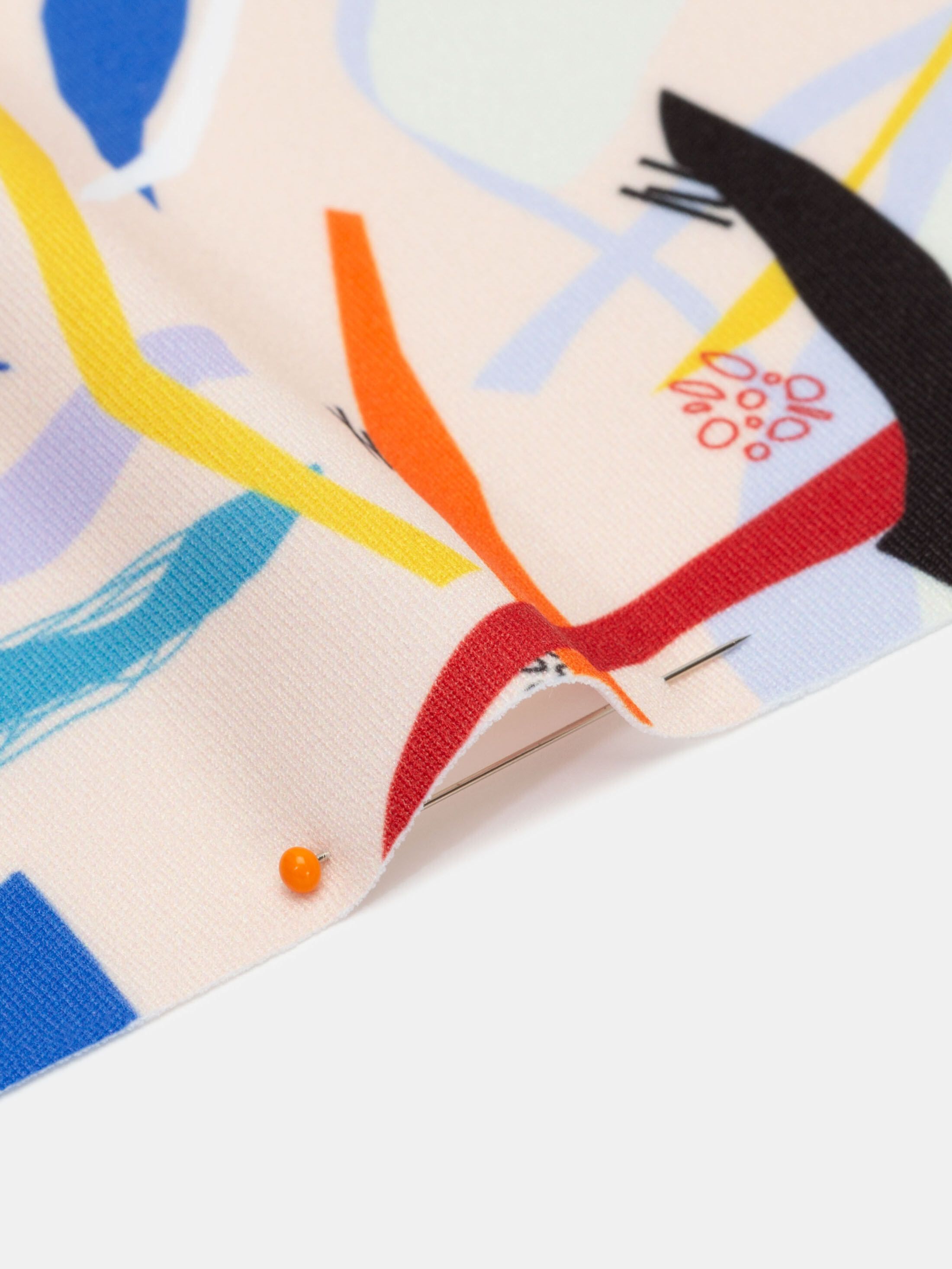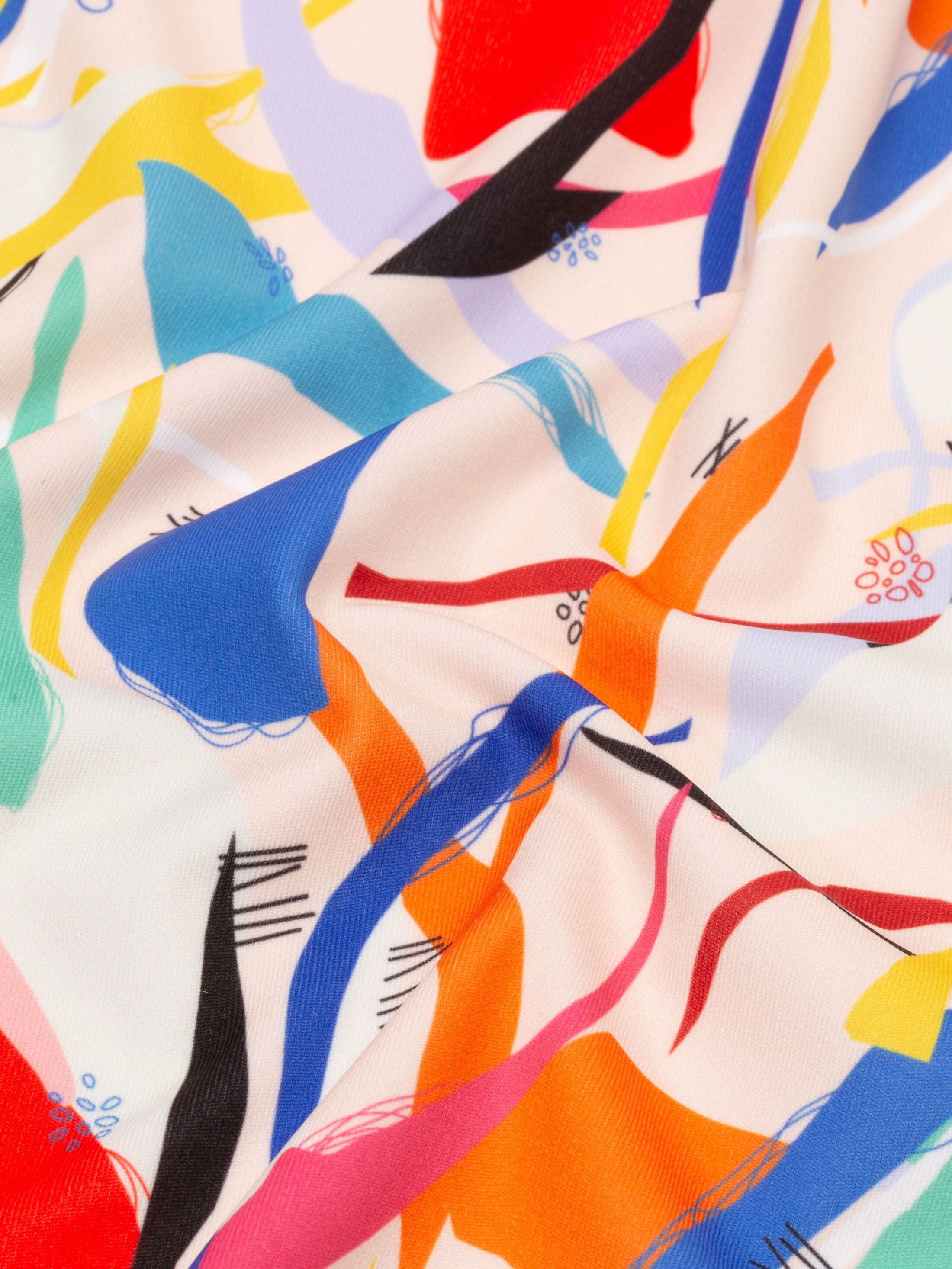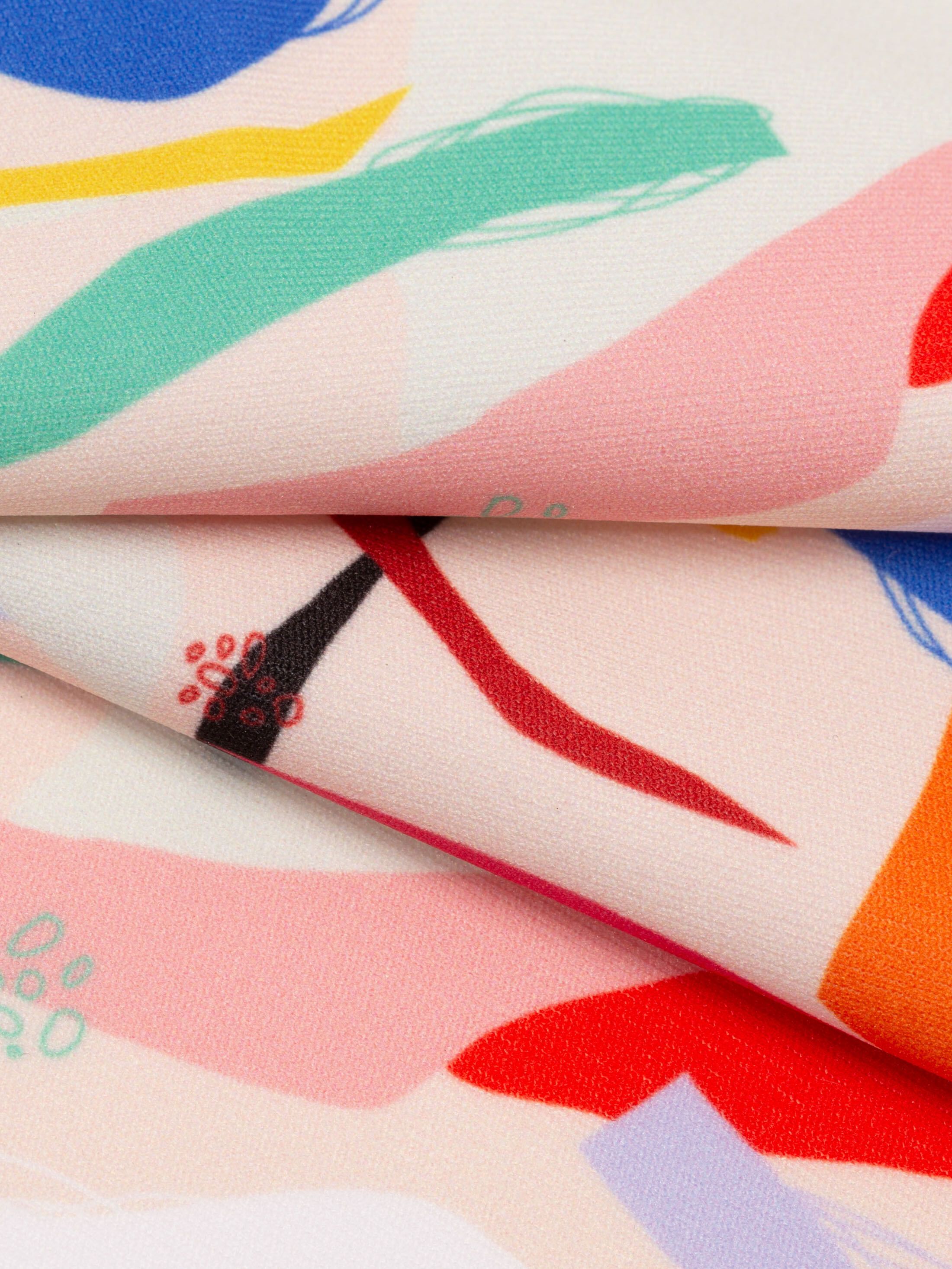Lycra Heavy Matte 250 gsm
From £14.75
per half sq m
92% poly / 8% elastane
1.45m Max Print
Sublimation inks
250gsm
Technical
Oeko-Tex Standard 100 Ink
Hemming Available
Sustainably printed in the UK
Explore our

Swatch packs and colour charts available for as little as £0.75 with next day delivery
Order a swatch packProduct Description
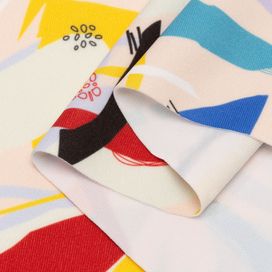
Care instructions
Wash at 30°C, low tumble dry heat, hang to dry, do not wring, low heat iron.
Not sure if this is the right fabric or need some more inspiration?
Order a fabric test print £5.95How it works
Upload your design
We automatically apply your design to the product you selected
Make it perfect
Use our smart tools to get it exactly right and select the finishing options
Preview & checkout
Confirm your designs with our 3D previews and checkout with confidence
1-2 Days Production
Sit back and relax. Your product is on its way!
How our pricing works
Standard fabric sizes
Our pricing is based on the quantity and dimensions of the products you order. The more you order, the better price you’ll get. We also offer lower pricing for larger dimensions, students and wholesalers.
Finishing price list
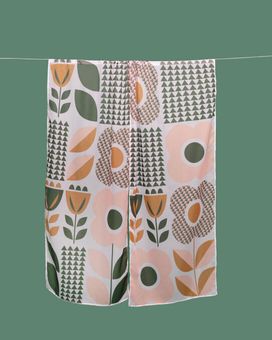
We have a full Cut & Sew service here at Contrado, and are able to hem your fabric prints for a small additional charge per metre.
- Folded hem (range of 8 thread colours)
- Overlock hem (range of 8 thread colours)
- Cut on the line
- Pinked edge
You can choose to have your prints hemmed with either black or white thread. The hemming material allowances can be found in our Print guidelines & finishing section of our FAQs.
View our full FAQsWe offer discounts
We offer discounts on all our products, including bulk, quantity and student discounts. Enjoy great deals whether you're a small business, designer, or student.
|
Volume in
sq m
sq m
sq yard
|
Price | Discount |
|---|---|---|
| <= 0.5 sq m | £ 14.75 fixed | 0.0% |
| 0.5 - < 1.0 sq m | £ 29.50 /sq m | 0.0% |
| 1.0 - < 3.0 sq m | £ 29.50 /sq m | 0.0% |
| 3.0 - < 10.0 sq m | £ 28.50 /sq m | 3.4% |
| 10.0 - < 20.0 sq m | £ 28.00 /sq m | 5.1% |
| 20.0 - < 30.0 sq m | £ 27.00 /sq m | 8.5% |
| 30.0 - < 40.0 sq m | £ 26.00 /sq m | 11.9% |
| 40.0 - < 50.0 sq m | £ 25.00 /sq m | 15.3% |
| 50.0 + sq m | £ 20.00 /sq m | 32.2% |
** For larger projects or custom inquiries, please contact us.
** All prices listed above are determined per 1 unit width.
Delivery time & costs
Lycra Heavy Matte 250 gsm
From £14.75
per half sq m | VAT included
92% poly / 8% elastane
1.45m Max Print
Sublimation inks
250gsm
Technical
-
Oeko-Tex Standard 100 Ink
Hemming Available
Sustainably printed in the UK
Explore our

Swatch packs and colour charts available for as little as £0.75 with next day delivery
Order a swatch packHelp
Origin of Heavy Matte Lycra
Lycra is a trademarked name for a type of spandex fiber developed by the American chemical company DuPont in the 1950s. The name "Lycra" has since become synonymous with stretchy, form-fitting fabrics, and is widely used in the fashion and sportswear industries.
The heavy matte version of Lycra fabric, which has a more substantial weight and a matte finish, was likely developed in response to the growing demand for high-quality, performance-oriented materials in the sportswear market. This type of fabric is particularly well-suited to sports and athletic activities because of its stretch and recovery properties, which allow it to move with the body and provide support and compression where needed.
While the exact origin of heavy matte Lycra fabric is unclear, it is likely that it was developed through a combination of research and development efforts by textile manufacturers and fabric mills. Today, heavy matte Lycra is widely used in the production of sportswear and activewear, as well as in other applications where stretch, durability, and comfort are key requirements.
Surface textures
Lycra heavy matte has a smooth surface texture with a matte finish, which gives the fabric an understated, subdued appearance. This slightly stretchy and elastic textile has a good drape and holds its shape well, even after being stretched and worn repeatedly.
Print detail
The lycra fabric has a white base tone. There's a slight opacity to the fabric allowing light to shine through. We print using sublimation inks that offers saturated colours, and can withstand repeated washes.
Usage
Lycra heavy matte fabric is ideal for creating sleek, streamlined garments that offer both comfort and support. It is a popular choice for sportswear and activewear.
Print Guideline
What's the best resolution to print in?
We print at 200dpi, which is a good combination of quality and file weight. Ideally, your image should be scaled to 100% at 200dpi; this means that no resizing of your file occurs, preventing any interpolation. Our design interface will have a quality marker next to the design that you have uploaded, this will change colour using a traffic light system and display a message. The message will let you know if the resolution is too low or if you have a good quality image.
How will my image scale?
When you upload your design our system will automatically scale it to fit your chosen fabric dimensions. In the ‘Product Options’ tab, the displayed dimensions under ‘Print Size’ will show the dimensions of the piece of fabric that you are ordering. For image/design dimensions you need to see the ‘Images & Text Tools’ tab. You can see and edit the dimensions of the image under the quality information next to the thumbnail.
Which colour model should I choose? RGB or CMYK?
We advise providing images in the RGB colour space. Specifically using the sRGB image profile, to achieve best colour results. What does this mean? In your editing software choose RGB as the working space, and assign the image profile as sRGB (full name sRGB IEC61966-2.1)
Maximum dimensions
For most of our fabrics, there is no limit on the length of the fabric that you can order. We have a preview design window set up to 10m max to visualise the print, but that's not a print limit. If you'd like to order more, increase the quantity (x2 for 20m or x4 for 40m for example) and then you can order as much as you'd like, with a built-in automatic volume discount too. The maximum print width of each fabric can be found on the individual fabric pages or in our design interface.
Do I need to incorporate white space within my design if I want a border or some cutting space?
Yes, that might help you! Always incorporate any extra space or borders into your purchased fabric size. We trim squarely around fabric samples and fabric prints, leaving approximately 5mm white space. Cutting neatly on the line has an additional fee.
What is crocking and why might it occur?
Crocking, which is fading along the creases, often after washing or heavy use, occurs when you digitally print on natural fabrics - more so when dark or dense colours are used. It can be minimised by using a cool hand wash instead of machine washing as the tumbling of the machine is the main cause of this. To avoid entirely, we would advise using a poly fabric.
Why do my colours appear lighter on organic fabrics?
Our organic fabrics do not have any coatings that the non-organic fabrics have. This means the ink absorbs into the fibres, reducing the colour strength slightly (by approx. -40%). For super strong colours we recommend a non-organic natural fabric.
Do you print on fabric a customer supplies?
Unfortunately not; we like to test meticulously so that we know what gets best results on our fabrics, and our facilities cater perfectly to them. We do however print sublimation paper to order, and if you have access to a heat press you can press your own fabrics easily.
Should I save my file as a TIFF or JPEG?
For multi-coloured or very detailed files we recommend using a tiff format, but they must be flattened. For simple colours and low detail files, a jpeg is fine.
What is the situation with material shrinkage?
Just like many fabric printing processes, there is the potential for shrinkage. Depending on the fabric, please expect and allow between 2-8% shrinkage which you need to plan for in your dimensions. This percentage can vary from print run to print run and between fabrics, so we would advise ordering a little more material than you require for your project.
Can I print on both sides of the fabric?
We do not offer to print on both sides of the fabric. A lot of our fabrics are semi-transparent or have some show through and this wouldn't work with double-sided printing. This is not a service that we offer on any of our fabrics.
Can I order labels in another fabric? Would you cut them as you do with the normal fabric labels?
At the moment no, our labels are all printed on the same satin fabric. We may introduce more in the future, but for now, this is the best choice. The labels are all cut the same way. You can order the fabric of your choice and make the labels yourself, but we do not cut different fabric into label format.
How is your fabric printing eco-friendly?
With environmental consciousness in mind, our fabrics are all printed using completely water-based inks. This means no chemicals or solvents are used. Our heat fixing procedure fixes the colours and prints, avoiding the downsides of steaming, such as excess or contaminated water returning into the waste system. We have one facility in London where we conduct all the printing, production and fulfilment. Rather than roll the fabrics, or send them in a tube, we fold them before they are sent out to you. This saves over 150 tubes a week, as well as a lot of space on the delivery van. (For delicate fabrics we ensure to package appropriately).
Why are there slight colour differences between my orders?
We work at improving our colour profiles all the time. Though rare it may happen that from one print run to another, and there could be slight colour differences, this is normal and part of the process when we are constantly improving. It is extremely unlikely that there will be a huge difference (like orange instead of red for example). Please bear in mind such colour variations can be intensified from fabric to fabric due to the varying grains and textures of the fabric; natural fabrics tend to have more muted colours than their poly alternatives. This is due to the construction of the materials as well as the print methods that have to be altered slightly for more delicate, natural textiles.
Sizing For Hemming And Shrinkage
We have a full Cut & Sew service here at Contrado, and are able to hem your fabric prints for a small additional charge. We create a small one- or two-fold hem that typically uses 5 to 20mm of material, depending on the thickness of the fabric. So, for example, if you want a finished piece of fabric that measures 100 x 100cm, you will need to order a size of 101.5cm x 101.5cm to allow for the hem (on top of that please also allow for shrinkage of min 2%). The thicker the fabric, the bigger the hem will be. You can choose to have your prints hemmed with either Black or White thread. On our silk and other light woven fabrics, one hemmed edge will be straight (vertically down the roll) and the other will be slightly rippled. The hemming material allowances are as follows and you need to make your print bigger to accommodate the hem:
- Light Fabrics (20-100gsm): For silks and other light fabrics, we use 6-8mm in the hem (2 fold), so overall width/height will be minus 12-16mm
- Medium Fabrics (101-200gsm): For medium-weight fabrics that fray, we use 15-20mm in the hem (2 fold) so overall width/height will be minus 35-40mm
- Stiff/Heavy/No-fray fabrics: we use 15-20mm in the hem (1 fold) so overall width/height will be minus 35-40mm
How Would you Like the Edge?
We have four finishing options for your fabric order:- As it comes. We cut around your image, leaving a simply scissor cut, perhaps uneven white fabric border.
- Hem with thread. We can hem your fabric with a choice of black or white thread. Please allow 1-2 days of additional production time. See below for information on how hemming affects the size of your print. We offer an overlock hem, as well as a folded hem (one or two fold depending on the fabric) however not all fabrics, are suited to both hem types. If you can see both options, it means both are suitable, and you will be able to choose whichever you prefer.
- Cut on the line. We will cut neatly on the edge of your design. This means that if you have a border around your design we will cut around that border, if your design takes the whole space of the fabric, then we will neatly cut around the edge of that image. Please be aware, when we cut along the line, we have to cut against the grain of the fabric. This is the standard procedure for fabric cutting. This means that with some fabrics, for example, Georgette and Mulmul, which have a slight wave in them, some fraying will occur. This is unavoidable, as the cut follows the grain of the textile.
For further information about our fabrics see our FAQs.
Please note: As everything we provide is handmade to order, you may find a slight variance in the sizes.
Do you print on both sides of the fabric?
We only print on one side of the fabric.
What kind of edge finishes do you offer?
You can opt for an uneven scissor cut where we cut around your image. There might be some uneven white fabric border left behind. Or you can opt for the overlock hem in either white or black thread. The third option is 'cut on the line' wherein we will cut neatly on the edge of your design. This means that if you have a border around your design we will cut around that border, if your design takes the whole space of the fabric, then we will neatly cut around the edge of that image. Please be aware, when we cut along the line, we have to cut against the grain of the fabric. This is the standard procedure for fabric cutting. This means that with some fabrics, for example, Georgette and Mulmul, which have a slight wave in them, some fraying will occur. This is unavoidable, as the cut follows the grain of the textile. All of our fabrics are cut manually by hand, with the utmost care and attention. If your fabric has a slightly uneven look on the edges or a touch of fraying, this does not indicate a flaw in the textile. It is not always possible to achieve a perfect straight cut with certain fabrics, so please do bear this in mind when it comes to your design.
What can I make with heave matte lycra?
You can use it for making yoga wear, leggings, cycling shorts and tops and even costumes for Cosplay.
Rub Fast 20k
BS EN ISO 12947 > 20,000 revs Martindale: Fabric withstood Martindale rub test to 20,000 revolutions. What you can say to your customers: Suitable for use in medium wear applications.
Rub Fast 30k
Martindale BS EN ISO 12947 30,000 revs: Fabric withstood Martindale rub test to 30,000 revolutions. What you can say to your customers: Suitable for use in medium-high wear applications.
Rub Fast 40k
Martindale BS EN ISO 12947 40,000 revs: Fabric withstood Martindale rub test to 40,000 revolutions. What you can say to your customers: Suitable for use in high wear applications.
Rub Fast 80k
Martindale BS EN ISO 12947 80,000 revs: Fabric withstood Martindale rub test to 80,000 revolutions. What you can say to your customers: Suitable for use in high wear / Severe Contract applications.
BS 5722:1984. Flammability for nightwear
This fabric complies with the flammability performance requirements of The Nightwear (Safety) Regulations 1985. (Statutory Instrument 1985 No 2043)
BS476 Wall coverings
BS476 part 7 1997, classification of the surface spread of flame. What you can say to your customers: Safe to use for wallcoverings in public spaces and/or where BS476 is required.
BS5722 Nightwear
Fire tests according to BS 5722:1984. Flammability in accordance with The Nightwear (Safety) Regulations 1985 (Statutory Instrument 1985 No 2043). What you can say to your customers: Safe to use for nightwear garments such as pyjamas.
BS5852 Schedule 4 Part I
THE FURNITURE AND FURNISHINGS (FIRE) (SAFETY) REGULATIONS 1988 The sample submitted, when tested complies with the requirements of Schedule 4 Part I. (Cigarette Resistance)
BS5852 Schedule 4 Part I & Schedule 5 Part 1
THE FURNITURE AND FURNISHINGS (FIRE) (SAFETY) REGULATIONS 1988 The sample submitted, when tested complies with the requirements of Schedule 4 Part I (Cigarette Resistance) and Schedule 5 Part 1 (Match resistance).
BS5867 Curtains and drapes
The sample received meets BS 5867 : 2008 Specification for Fabrics for Curtains, Drapes and Window Blinds, Part 2, Flammability Requirements, Type B.
DIN EN 13501-1:2010 Wallcoverings
DIN EN 13501-1:2010 B-s1,dO. What you can say to your customers: European Standard specifies the reaction to fire classification procedure for all construction products, including products incorporated within building elements.
EU Ecolabel Certified Recycled
The yarn has been certified recycled by "EU ecolabel". What you can say to your customers: Printed on recycled fabric.
Global Recycled Standard (GRS)
The yarn has been certified recycled by the Global Recycled Standard (GRS). What you can say to your customers: Printed on recycled fabric.
Bleach Cleanable
ISO 105 E03 colour change 4 for dilution factor 1:4 chlorine solution. This fabric can be washed with a weak bleach solution if required, using no greater than 1% bleach concentration
BS 2823 Breathability
Breathable/waterproof certification BS 2823:1982, BS7209:1990. What you can say to your customers: Fabric is breathable.
BS EN 13758 UV Protective
Classification and marking of solar UV protective properties BS EN 13758-1:2002+A1:2006. What you can say to your customers: Fabric has UV protective properties.
Dimensional Stability to Washing
BS EN ISO 6330 @ 30°C. Tested for shrinakge % in a 30°C washing cycle. With shrinakge less than <2%.
EN71 Toy Safety
European standard EN 71 specifies safety requirements for toys. Compliance with the standard is legally required for all toys sold in the European Union.
Oeko Tex Standard 100 Fabric
The production of the fabric meets Oeko Tex Standard 100. What you can say to your customers: Printed on OEKO-TEX 100 certified fabric.
Oeko Tex Standard 100 for dyeing
The dyeing of the fabric meets Oeko Tex Standard 100 Fabric dyeing. What you can say to your customers: Printed on fabric that meets OEKO-TEX 100 certification for dyeing.
Resistance to Pilling
This test specifies the resistance of a fabric to pilling, fuzzing, and matting of textile fabrics. Grade 3/4 represents appropriate for use in high wear garments.
Resistance to Pilling
BS EN ISO 12945. Grade 3/4 This test specifies the resistance of a fabric to pilling, fuzzing, and matting of textile fabrics. Grade 3/4 represents appropriate for use in high wear domestic environments.
Seam Slippage <3mm@180N
BS EN ISO 13936. Seam slippage occurs when a seam tends to open or break under the influence of a force applied perpendicular to the direction of the seam. This fabric scores 3mm@180N or less, which represents a good fabric for upholstery in domestic or public areas.
Tear Strength ≥30N+
BS EN ISO 13937. This standard provides a method for determining the force required to tear a fabric. This fabrics scores above ≥30N+ which represents a good fabric to use for upholstery in domestic or public areas.
Tensile Strength 600N+
BS EN ISO 13934. The tensile strength of a material is a measure of the force required to pull it apart. This fabric scores 600N+ which represents a good fabric for upholstery in domestic or public areas.
BCI organic Fabric
The yarn has been certified organic by BCI Better Cotton Initiative. What you can say to your customers: Printed on Organic fabric.
GOTS organic Fabric
The yarn has been certified organic by GOTS. What you can say to your customers: Printed on Organic fabric.
GOTS ECOCERT Certified Ink
Printed using ECOCERT GOTS certified inks. This means they have been independently certified to ensure they have been made in a socially responsible and environmentally friendly manner. What you can say to your customers: Printed using ECOCERT GOTS certified inks. This means they have been independently certified to ensure they have been made in a socially responsible and environmentally friendly manner.
Greenguard Certified
Products that have achieved GREENGUARD Certification are scientifically proven to meet some of the world’s most rigorous third-party chemical emissions standards, helping to reduce indoor air pollution and the risk of chemical exposure. Printed with GREENGUARD approved inks are suitable for use in the home, schools, offices an hospitals. What you can say to your customers: Printed with GREENGUARD approved inks, suitable for use in the home, schools, offices an hospitals.
Oeko-Tex Standard 100 Ink
Printed using OEKO-TEX Eco Passport certified ink. This means they have been independently certified to ensure they have been made in a socially responsible and environmentally friendly manner. What you can say to your customers: Printed using OEKO-TEX Eco Passport certified ink. This means they have been independently certified to ensure they have been made in a socially responsible and environmentally friendly manner.

